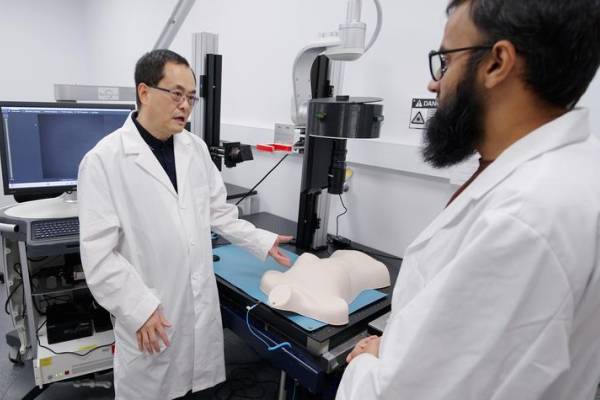Sanders-Brown study: Long-read RNA sequencing reveals key gene expressions in Alzheimer’s disease

Researchers at the University of Kentucky Sanders-Brown Center on Aging are working to develop a pre-symptomatic disease diagnostic tool for Alzheimer’s disease.
“While the need for better treatments is clear, such treatments will not be very meaningful if they are administered after symptoms have onset. By then, Alzheimer’s disease has been ravaging the brain for decades to the point the brain can no longer compensate for the extreme cellular death,” said Mark T. W. Ebbert, Ph.D., Sanders-Brown faculty and an associate professor in the Department of Internal Medicine in the College of Medicine with a joint appointment in the Department of Neuroscience.
Ebbert is leading the research team behind the study titled “Mapping medically relevant RNA isoform diversity in the aged human frontal cortex with deep long-read RNA-seq” that was recently published in Nature Biotechnology.
He is also the principal investigator on multiple awards totaling nearly $5 million from the National Institutes of Health along with grants from the Alzheimer’s Association, the BrightFocus Foundation and PhRMA Foundation that funded that project.
Ebbert’s team includes lead authors Bernardo Aguzzoli Heberle, a Ph.D. candidate at Sanders-Brown, and Jason A. Brandon, Ph.D., a scientist at Sanders-Brown and the Department of Internal Medicine.
The team is using a cutting-edge technique known as long-read sequencing. These technologies allow for a new level of analysis of DNA and RNA, which is the molecule that helps translate genetic code from DNA into proteins.
A single human gene can produce multiple different RNA and protein molecules, called isoforms, allowing it to perform multiple functions. Long-read sequencing helps Sanders-Brown researchers identify and measure these RNA isoforms from a single gene across the entire genome. This also overcomes technical limitations from standard short-read sequencing.
“As a proof of principle, we sequenced aged frontal cortex brain tissue — both healthy brains and brains with Alzheimer’s disease. Our team identified 99 RNA isoforms that were either increased or decreased in Alzheimer’s brains, even when the overall gene activity didn’t change,” said Ebbert. “This shows the importance of understanding isoforms and their unique functions in a gene along with their roles in human health and disease. In fact, we found more than 1,900 genes expressing multiple RNA isoforms related to human disease.”
The team at Sanders-Brown found some of those genes are medically relevant in brain-related diseases, including Alzheimer’s disease, Parkinson’s disease, autism spectrum disorder and substance use disorder.
“This step in understanding the human genome is exciting, but it is simply not enough. We have so much more to do to understand how individual RNA isoforms are involved in diseases, including Alzheimer’s disease, and how to target them therapeutically. There is so much work to do if we are going to defeat Alzheimer’s disease,” said Ebbert.
The team also discovered five new, complex RNA variants from mitochondrial DNA. Researchers believe this is the first study to identify this genetic material in human tissue.
“Although their expression is low, these genes could serve as biomarkers for mitochondrial function, which play an important role in many age-related diseases. It’s crucial to understand the role these new isoforms play in human health and disease,” said Ebbert.
Sanders-Brown scientists hope these findings can lead to new and more precise targets for disease treatment and diagnosis across a broad range of complex human diseases.
“With this method, we’ve shown there’s potential to specifically target isoforms that are either promoting cellular health or dysfunction rather than treating a gene as a single entity,” said Ebbert. “The analysis can also help us reveal unique signatures in Alzheimer’s disease not detectable at the gene level.”
Researchers say larger studies are needed to better understand the RNA patterns in complex diseases and deep long-read RNA sequencing will be a necessary tool for that work.
“We are also incredibly grateful to the patients who’ve donated to the UK Alzheimer’s Disease Center Tissue Bank,” said Ebbert. “Without their participation, this level of scientific study would not be possible.”
This study brought together a team of researchers from the UK College of Medicine’s Department of Pharmacology and Nutritional Sciences; Department of Pathology and Laboratory Medicine; and Department of Microbiology, Immunology, and Molecular Genetics; Emory University School of Medicine in Georgia; University College of London in the United Kingdom; Cold Spring Harbor Laboratory in New York; and the Mayo Clinic in Arizona.
The full study can be found online.
Research reported in this publication was supported by the National Institute of General Medical Sciences of the National Institutes of Health under Award Number R35GM138636 and the National Institute on Aging of the National Institutes of Health under Award Numbers R01AG068331 and P30AG072946. The content is solely the responsibility of the authors and does not necessarily represent the official views of the National Institutes of Health.
Acknowledgment is made to the donors of Alzheimer's Disease Research, a program of BrightFocus Foundation, for support of this research.
This work was supported by a grant from the Alzheimer's Association 2019-AARG-644082.
More from this series Research Priorities - Neuroscience
Credits
Words: Lindsay Travis (Research Communications)
Photo: Pete Comparoni (UK Photo)


